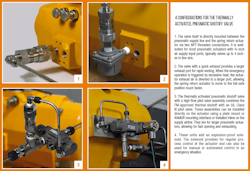Assured Automation FM fire-safe shutoff assemblies are American Petroleum Institute (API) 607 and FM approved for flammable liquids and are commonly used to:
- Shut down hazardous lines when fire occurs (normally open — spring to close)
- Activate sprinkler systems by releasing a fire retardant, to control fire (normally closed — spring to open)
The heat-actuated, FM & Underwriters Laboratories (UL)-listed thermal links automatically shut or open the valve at trigger temperatures. A removable handle allows for the manual operation of a ball valve without affecting the fusible link. Removing the handle prevents injury or damage from the high-powered, quick-acting actuator if the fusible link is triggered.
The assembly requires limited maintenance, and the UL-listed fusible links are installed onto a lever mechanism, rather than bearing 100 percent of the spring tension. With this design, the FM-approved fusible link withstands many years of use — an advantage when compared to other thermal shutoffs that require annual link replacement.
The assembly is also available with an electrothermal link, which can be used with most smoke or gas detectors, as well as with any manually activated electrical signal. The operating range for the electro-thermal link is 6 to 30 volts (V) alternating current, or 6 to 30 V direct current, and requires less than 0.2 amperes of power, 0.5 milliseconds at 24 V.
Traditional safety with emergency isolation valves
When flammables and toxic media flow through a process that requires startup and shutdown, locally and remotely, pneumatic actuators often control the opened and closed states of the valve. Traditionally, fire safety in pneumatically controlled processes required two complete valve assemblies — one valve assembly with the fusible link for emergency shutoff and a second valve assembly with the pneumatic actuator for normal process control. For large lines and valves, the space requirements and cost of the second valve assembly could add significant expense to a project.
The introduction of manual overrides to the fusible link assembly was an early improvement. Prior to this advance, process designs required a third valve assembly to allow for manual operation.
Improved process fire safety
With restrictions on space and cost, instrumentation engineers can now simplify their emergency shutoff using the thermally activated, pneumatic shutoff valve right on the pneumatic actuator. When a fire occurs, the FM-approved shutoff valve on the pneumatic actuator automatically vents the pneumatic actuator, allowing it to move into its fail-safe position (open or closed). At the same time, it closes the supply airline, eliminating oxygen that would feed the fire. A second entire fusible link valve assembly dedicated to the thermal shutdown is no longer required.
FireChek-equipped, pneumatically actuated valve is testable and resettable (left). Pneumatically actuated valve plus a valve with spring-loaded actuator with fusible link is not testable and resettable (right).The single-valve assembly with FireChek is functionally equal to these two valve assemblies.
This shutoff valve allows any pneumatically operated valve to also provide thermal shutoff while maintaining its original functionality, whether it is on, off or modulating. These assemblies can also be equipped with a manual override, which usually comes in the form of a screw-drive, geared hand wheel.
Another advantage when compared to fusible links is this shutoff valve’s reset ability. Instead of a melting metal alloy that is destroyed once triggered, this shutoff uses a shape-memory alloy that is not destroyed after triggering. Once triggered and allowed to cool, it can be reset with a simple, manual twist.
In contrast, once a fusible link is triggered, it must be replaced, and the spring canister requires retensioning to the proper torque. This reset ability allows the thermal function to be tested and reset as part of a regular safety monitoring and maintenance program.
Quickly triggered, this unique shutoff valve drives pneumatically operated process valves to their fail-safe position for on/off and throttling applications. Because it responds to heat, not flame, it offers dramatically improved protection compared with conventional plastic burn-through tubing. While burn-through tubing does effectively allow the pneumatic actuator to return the valve to fail safe, it does not stop the air from feeding oxygen to the fire like the FireChek does.
The shape-memory element senses the ambient temperature and, through a phase induction change, rapidly produces the force and motion to trigger the valve. The element is 100 percent reliable because the shape-memory effect is intrinsic to the alloy. Shape-memory alloys have performed successfully for many years in military, industrial, biomedical, aerospace, robotics and consumer product applications.
Local shutoff
- Automatic shutoff through thermal (fire) actuation; when fusible elements are used they shall have a melting point not exceeding 250°F
- Manual shutoff from a remote location
- Manual shutoff at the installed location
Easy retrofits
All configurations — a heat-activated, pneumatic shutoff alone, one with quick exhaust, or one with a pilot valve — can easily be retrofitted onto any pneumatically actuated process valve. The valve or actuator does not need to be removed from the pipeline. A simple insertion of the heat-activated, pneumatic shutoff into the actuator’s supply airline is all that is required. Thermal shutoffs do not affect normal plant operations or the normal function of the control valve.
Applications
These heat-activated pneumatic shutoff valves are used in batch and continuous process systems such as those found in oil refining, paper manufacturing, chemical facilities, pharmaceutical companies and power plants. Early adopters of these shutoffs include NASA. LNG facilities and cryogenic vessels also have adopted thermal shutoffs because of their severe space restrictions. Refineries use multiple fire shutoffs to help reduce costs and benefit from the ability to test them regularly.




